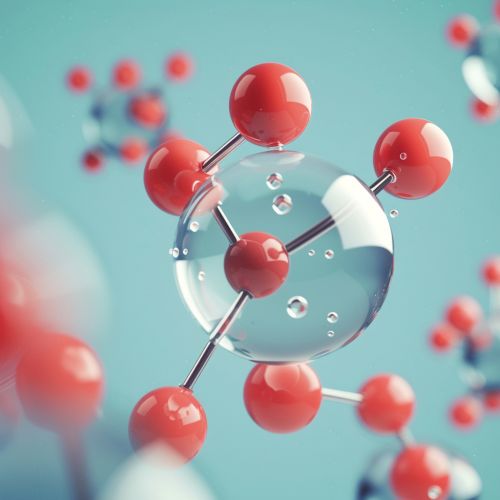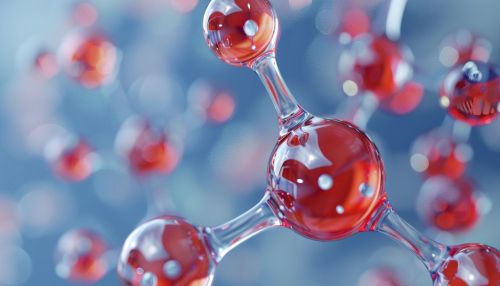Polar molecule
Introduction
A polar molecule is a chemical species in which the distribution of electrons between the covalently bonded atoms is not even. This uneven distribution results in a molecule having a partial positive charge on one end and a partial negative charge on the other, creating a dipole moment. The concept of polarity is fundamental in understanding the behavior of molecules in various chemical reactions and interactions, particularly in solutions.
Molecular Polarity
Molecular polarity arises from the differences in electronegativity between atoms in a molecule. Electronegativity is the tendency of an atom to attract electrons towards itself. When two atoms with different electronegativities form a bond, the electrons are more likely to be found closer to the more electronegative atom, resulting in a polar bond. For example, in a water molecule (H₂O), the oxygen atom is more electronegative than the hydrogen atoms, leading to a partial negative charge on the oxygen and a partial positive charge on the hydrogens.
Dipole Moment
The dipole moment is a vector quantity that represents the separation of charges in a polar molecule. It is defined as the product of the magnitude of the charge and the distance between the charges. The dipole moment is expressed in Debye units (D). A molecule with a higher dipole moment is more polar. For instance, the dipole moment of water is approximately 1.85 D, indicating its significant polarity.


Factors Affecting Polarity
Several factors influence the polarity of a molecule, including the shape of the molecule, the electronegativity of the atoms, and the presence of lone pairs of electrons.
Molecular Geometry
The shape of a molecule, determined by its VSEPR (Valence Shell Electron Pair Repulsion) theory, plays a crucial role in its polarity. Linear, bent, trigonal planar, tetrahedral, and other geometries can affect how the dipoles within a molecule add up. For example, carbon dioxide (CO₂) is a linear molecule with polar bonds, but the dipoles cancel each other out, making it nonpolar. In contrast, water (H₂O) has a bent shape, resulting in a net dipole moment.
Electronegativity Differences
The greater the difference in electronegativity between the bonded atoms, the more polar the bond. For instance, the bond between hydrogen and fluorine in hydrogen fluoride (HF) is highly polar due to the significant electronegativity difference between hydrogen and fluorine.
Lone Pairs of Electrons
Lone pairs of electrons on the central atom can also affect molecular polarity. These lone pairs can create regions of negative charge that do not cancel out with the dipoles of the bonds, leading to a polar molecule. For example, in ammonia (NH₃), the lone pair on nitrogen contributes to the molecule's overall polarity.
Examples of Polar Molecules
Several common molecules exhibit polarity due to their molecular structure and the presence of polar bonds.
Water (H₂O)
Water is one of the most well-known polar molecules. Its bent shape and the electronegativity difference between hydrogen and oxygen result in a significant dipole moment. This polarity is responsible for many of water's unique properties, such as its high boiling point and its ability to dissolve many ionic and polar substances.
Ammonia (NH₃)
Ammonia is another example of a polar molecule. It has a trigonal pyramidal shape with a lone pair of electrons on the nitrogen atom. The electronegativity difference between nitrogen and hydrogen, along with the lone pair, creates a net dipole moment.
Hydrogen Chloride (HCl)
Hydrogen chloride is a diatomic molecule with a significant electronegativity difference between hydrogen and chlorine. This difference results in a polar bond with a partial positive charge on the hydrogen and a partial negative charge on the chlorine.
Applications of Polar Molecules
Polar molecules play a vital role in various fields, including chemistry, biology, and materials science.
Solubility and Solvent Interactions
The polarity of a molecule greatly influences its solubility in different solvents. Polar molecules tend to dissolve well in polar solvents, such as water, due to the strong dipole-dipole interactions. This principle is the basis for the saying "like dissolves like." For example, ionic compounds like sodium chloride (NaCl) dissolve readily in water but not in nonpolar solvents like hexane.
Biological Systems
In biological systems, the polarity of molecules is crucial for the structure and function of biomolecules. For instance, the polar nature of water is essential for the formation of hydrogen bonds, which stabilize the structures of proteins and nucleic acids. Additionally, the polarity of phospholipids contributes to the formation of cell membranes, with hydrophilic heads facing the aqueous environment and hydrophobic tails facing inward.
Material Science
In material science, the polarity of molecules affects the properties of polymers, surfactants, and other materials. For example, the polar nature of certain polymers can influence their mechanical properties, solubility, and interactions with other substances.
Measurement of Polarity
The polarity of a molecule can be measured experimentally using various techniques.
Dielectric Constant
The dielectric constant is a measure of a substance's ability to insulate charges from each other. Polar molecules have higher dielectric constants compared to nonpolar molecules. This property is used to determine the polarity of liquids and solutions.
Infrared Spectroscopy
Infrared spectroscopy can be used to identify polar bonds within a molecule. Polar bonds absorb infrared radiation at specific frequencies, providing information about the molecular structure and the presence of functional groups.
Molecular Modeling
Computational methods, such as molecular modeling and quantum chemistry calculations, can predict the polarity of molecules. These methods use the principles of quantum mechanics to calculate the electron distribution and dipole moments of molecules.
Conclusion
Polar molecules are characterized by an uneven distribution of electrons, resulting in a dipole moment. The polarity of a molecule is influenced by factors such as molecular geometry, electronegativity differences, and the presence of lone pairs of electrons. Polar molecules play a crucial role in various chemical and biological processes, affecting solubility, molecular interactions, and material properties. Understanding the concept of polarity is essential for studying and manipulating the behavior of molecules in different environments.
